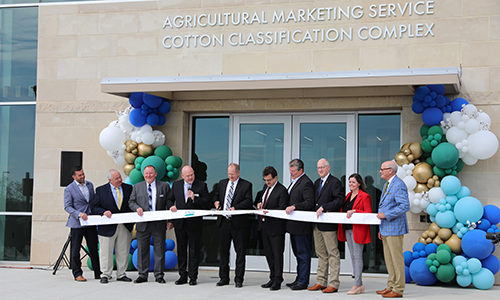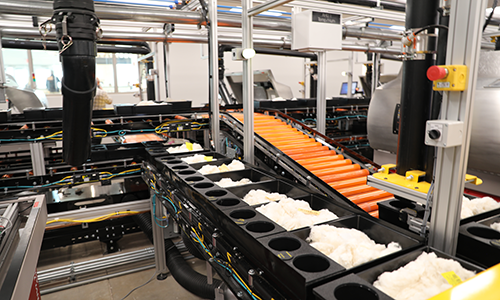by Aubry Heinrich
If you want to turn cotton into cash, the process starts with timely, accurate classing from USDA’s Agricultural Marketing Service that just launched its most high-tech laboratory in Lubbock.
In partnership with Texas Tech University, the USDA/AMS Cotton and Tobacco program opened the new Lubbock Classification Complex in September of this year. Bigger and better than ever, this flagship facility is equipped to process and class up to five million samples annually and simultaneously be AMS’s most energy-efficient. The 30,000-square-foot building is equipped with the latest equipment and technology.
“It has the capacity to class upwards of 60,000 samples per day with room for expansion if needed,” said Danny Martinez, Area Director of the USDA/AMS Cotton and Tobacco Program Lubbock Classification Complex. “The automation will enable the operations to not be as dependent on manual labor while optimizing the instruments throughout. This will help us to class the sample recipients accurately and timely.”
The automation systems the facility is utilizing are only available in four other classing labs, which maintains growers in the area receive the most accurate and prompt in- formation about their crops. The program is not sacrificing efficiency for uniformity. The equipment is frequently maintained and calibrated to confirm consistency in grading every sample.
“The operation uses an analytical-based quality management system that uses known-value cotton samples and materials throughout each shift to ensure all instruments are operating on the target levels for accuracy and consistency,” Martinez said.
Not only can the Lubbock Cotton Classification Complex process cotton samples quicker and more exact than ever, and it is also more energy efficient.
“This new facility will be a model for others to follow for cotton sample conveyance and energy efficiency,” Martinez said.
The laboratory needs to maintain a consistent temperature and humidity for precise grading. Heating and cooling this area can provide an energy efficiency challenge. However, the space uses the least amount of resources to heat, cool, and operate the building’s systems.
 “Mechanical Engineers incorporated features and equipment into the designs of this facility to increase energy efficiency,” Martinez said. “In cold weather, the outside air temperature is used to cool the water. When this occurs, the chiller shuts off, and natural cooling takes place. The laboratory has been designed with Insulated Concrete Forms (ICF) walls which create an insulated cooler effect that minimizes energy consumption.”
“Mechanical Engineers incorporated features and equipment into the designs of this facility to increase energy efficiency,” Martinez said. “In cold weather, the outside air temperature is used to cool the water. When this occurs, the chiller shuts off, and natural cooling takes place. The laboratory has been designed with Insulated Concrete Forms (ICF) walls which create an insulated cooler effect that minimizes energy consumption.”
The Lubbock laboratory is also set apart from all other classing facilities through its partnership with Texas Tech University.
“The facility is the only USDA AMS Cotton Classing Facility on a university campus,” he said. “We established the relationship with Texas Tech University to foster an impactful three-pronged approach of education, research, and employment moving forward.”
The cotton industry and Texas Tech have a long-standing relationship. The USDA partnership will allow the classing lab access to the resources the university has to provide.
“With the Lubbock Classification Complex being located on the Texas Tech Campus, it provides us with an opportunity to work with the university Fiber and Biopolymer Research Institute in cotton classification research,” Martinez explained.
Texas Tech University, USDA, and Martinez have great plans for the possibilities of the new classing complex.
“One of our visions was for the facility to be a teaching and learning facility – where cotton measurements, technologies, and utilization can be developed and improved,” Martinez said. “Where fields like engineering, analytics, textiles, material handling, and process control can be cultivated and enhanced, and where cutting-edge improvements can be realized.”
The classification process is an essential step in the marketing process. According to Martinez, the mission of this new facility is to provide the cotton classing service to growers for the fair and equitable marketing of their crop.
“The vision of USDA is to improve all facets of the classification process, such as the quality and efficiency,” he said. “This facility has many years of cotton classing experience incorporated into the design, and it is a model for future facilities.”
Martinez wants to reassure farmers the new classing office will significantly benefit their operation, especially during the big crop years.
“We will provide the cotton industry with a very efficient and accurate classing service,” he said. “We look forward to the future of our facility when we can handle the type of volume of samples the Lubbock region is usually known to produce.”


